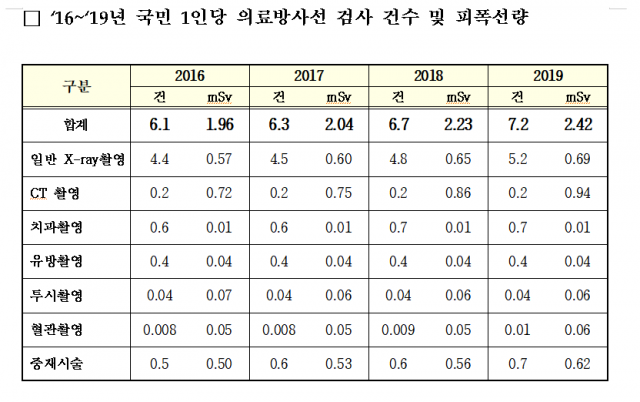CT/X-ray radiography test increased by 20% in 4 years
Radiation exposure dose per person 1.96mSv in 2019… Higher than the US, EU, etc.
 viewer
viewer
As the number of medical radiological tests such as computed tomography (CT) and X-ray imaging in Korea increased, the amount of radiation exposure increased by 20-25% over the past four years. In order to reduce the exposure to a higher level than overseas, it is expected that the number of exposures of patients and workers will need to be adjusted.
On the 8th, the Korea Centers for Disease Control and Prevention (KCDC) announced on the 8th the results of the investigation of the number of medical radiations for the purpose of diagnosis and intervention at medical institutions for four years from 2016 to 2019 for policy research service (Professor Kwang-pyo Kim, Kyunghee University). The subjects of this survey are the Health Insurance Review and Assessment Service, the National Health Insurance Corporation, the Korean Tuberculosis Association, the Ministry of Education, and military medical institutions.
As a result of the survey, the number of annual diagnostic medical radiation tests by the public rose from 31,227,9,177 in 2016 to 375,414,8,371 in 2019, an increase of about 20% over four years. This is an annual average increase of 6.2%.
When a medical radiation test is performed, the resulting radiation exposure also increases. According to the results of the survey, the annual exposure dose increased from 10,520 man·Sv (man·sievert) in 2016 to 125,388 man·Sv in 2019, an increase of about 25% over four years. It increased by 7.6% each year.
Man-Siebert is the sum of the individual radiation doses of the group when a large number of people are exposed. It is increasing to 2.42 mSv in 2019. This is a number that exceeds the US 1.88 mSv and the average of 0.97 mSv (0.25 mSv ~ 1.96 mSv) in 36 European Union countries in 2014. The exposure doses of major European countries are 1.96 mSv in Belgium, 1.67 mSv in Germany, 0.45 mSv in Finland, and 0.39 mSv in the UK, which are significantly different from those in Korea.
In particular, out of the total number of examinations, general X-rays accounted for 71.6% of the total (26,800 cases, 5.2 cases per person), and the total number of CT scans was only 3.2% (11.92 million cases, 0.2 cases per person), but the exposure dose. In, the exposure dose of CT scan was the highest at 38.7% (48,600 man·Sv, 0.94 mSv per person). General X-rays were followed by 28.6% (35,900 man·Sv, 0.69mSv per person).
The Korea Centers for Disease Control and Prevention (KCDC) said, “In order to lower the national medical radiation exposure dose, the’Medical Imaging Diagnosis Validity Guideline’ has been prepared and guided to medical institutions. We will prepare and implement short and long-term measures to reinforce the safety management of the company.” Reports on the number of national medical radiation cases and the status of exposure doses can be found on the website of the Korea Centers for Disease Control and Prevention.
/ Reporter Ji-hye Seo [email protected]
< 저작권자 ⓒ 서울경제, 무단 전재 및 재배포 금지 >
